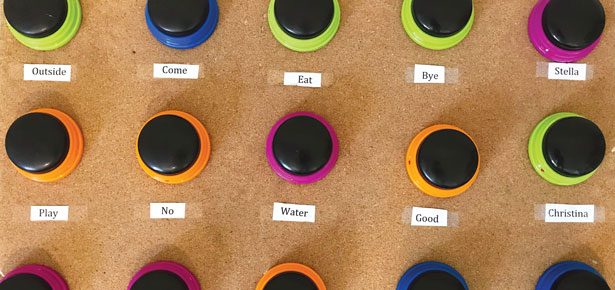

My Dog is Scared of Text Messages
Expert advice on fear triggers in dogs
Q: I have a female German Shepherd who has started freaking out when a text message comes through on my phone. She will jump behind or underneath furniture to hide, trembling, and won’t listen or acknowledge food; she totally shuts down. Calls and email notifications are fine. This behaviour started about 18 months ago. She has knocked furniture out of her way and gets stuck behind some. Now she will spend hours in the bathtub. Nothing bad or scary has ever happened concerning a text. She has no other problems except for this. Help?—Cathy Hebein
A: Goodness! If your dog is rushing to get away from the noise, refusing food, and trembling, she is truly afraid. The first thing I recommend is to immediately change the notification sound for your text. Your dog’s reaction is an extreme one, and you don’t want her to experience terror just because someone sends you a text. You may not remember something happening that caused your dog to become terrified of this noise, but she has obviously associated it with something really scary. Dogs have a better sense of hearing and smell than we do and she may have experienced something right after she heard the noise that frightened her. For example, I know a dog that is terrified of food bowls. He will only eat food off the floor. His owners cannot remember how he made the “food bowl = scary” association, but regardless the fearful association is there and now he will only eat food off the floor! You may never know why your dog is afraid of your text noise, but that doesn’t really matter. What does matter is that you recognized your dog is afraid, so let’s address the behaviour. Luckily, most smartphones allow you to play noises at will, so while you change your regular text notification noise to prevent it from scaring your dog, you can still access the noise that triggers her fear for desensitization training purposes. In order to help your dog get used to the noise, the first thing you need to learn is how far away, or how softly, you can play the noise without your dog having any reaction. If she tenses, starts pacing, whines or in any way shows stress, you are pushing her too fast. Make the sound softer or move it farther away until she shows no reaction. It’s better to err on the side of caution here, as you don’t want to scare her any more than she is already. You’ll need some really tasty treats that she loves. What is her favourite? Try grilled chicken, steak or turkey. Play the sound and immediately give her a treat. Repeat several times and quit. Training sessions should be very short. The goal is to try and change her association from a scary one to a pleasant one. Gradually, very slowly, make the sound louder. If you ever get to a point that she reacts, you pushed too fast. Don’t rush. With the level of fear your dog is displaying, it wouldn’t be unusual if this takes many sessions. You should be able to play the sound at slowly increasing levels without triggering a reaction. If you find this to be a challenge and she remains afraid, please contact a reward-based trainer in your area to help you. Fear is a tricky thing in dogs. A fear of one sound can generalize into fear of other things, so the sooner you can address this, the better!
Teoti Anderson, CPDT, owns Pawsitive Results (getpawsitiveresults.com), and is the past president of the Association of Pet Dog Trainers. She is the author of Your Outta Control Puppy, Super Simple Guide to Housetraining, Quick and Easy Crate Training, and Puppy Care and Training.
Join the newsletter and never miss out on dog content again!
"*" indicates required fields
By clicking the arrow, you agree to our web Terms of Use and Privacy & Cookie Policy. Easy unsubscribe links are provided in every email.





